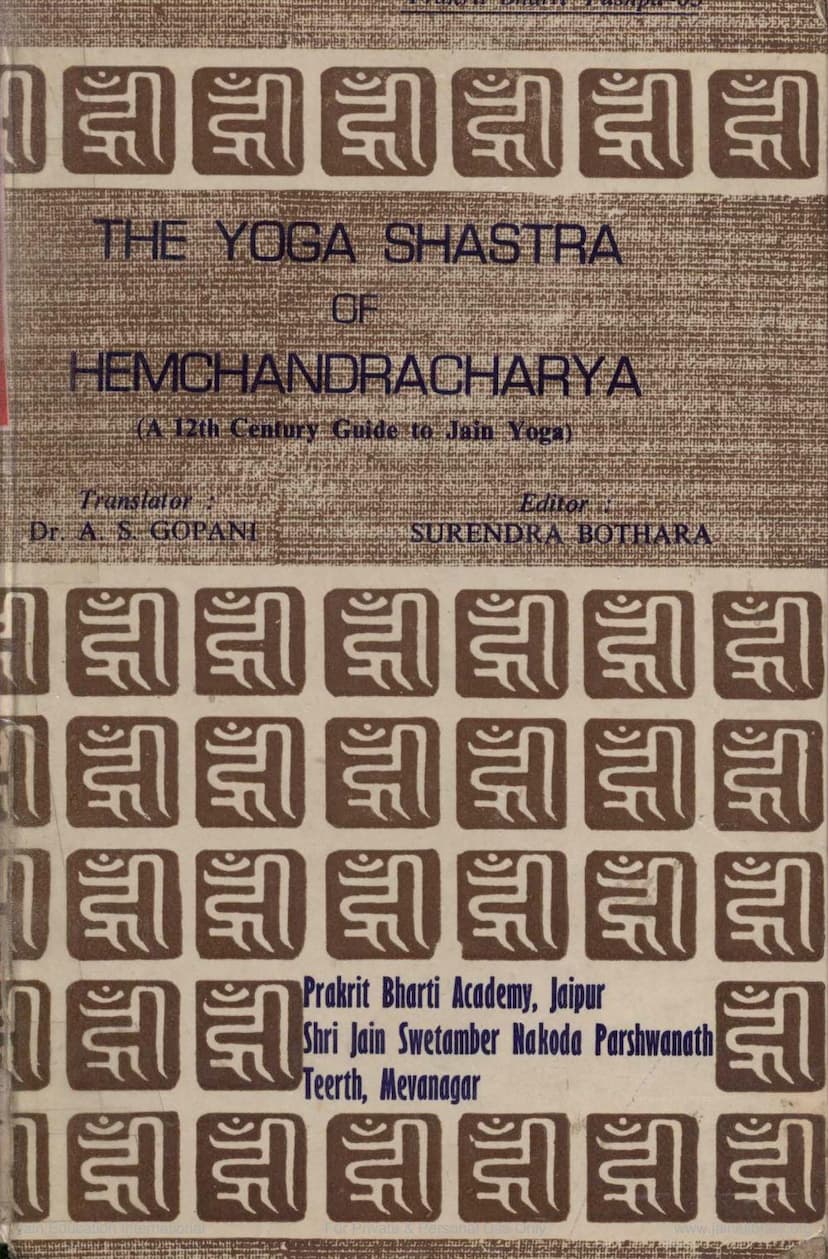Yogashastra Of Hemchandracharya
Added to library: September 2, 2025

Summary
Here is a comprehensive summary of the Yogashastra of Hemchandracharya, based on the provided text:
The Yogashastra of Hemchandracharya is a significant 12th-century guide to Jain Yoga, aiming to make the principles of yoga and meditation accessible to laypeople. Translated by Dr. A. S. Gopani and edited by Surendra Bothara, this work is published by Prakrit Bharti Academy.
Core Message and Significance:
- Jain Yoga for the Layman: Hemchandracharya's Yogashastra is unique in that it starts at the level of the common person, making complex spiritual concepts understandable.
- Integration of Tradition and Experience: The text draws upon traditional Jain knowledge and Hemchandra's own profound meditative experiences.
- Emphasis on Behavioural Discipline: Unlike many other yoga texts that focus heavily on physical aspects, Hemchandra stresses behavioral disciplines, the improvement of attitudes, and the cultivation of virtuous feelings.
- Foundation in Jain Philosophy: The work is built upon the fundamental Jain concept that the soul is encrusted with karmic particles, affecting its manifestation through the physical body. The process of liberation is detailed as the shedding of these karmic particles.
Structure and Content (Eleven Chapters):
The Yogashastra is structured into eleven chapters, covering a wide spectrum of Jain yoga practices:
-
Chapters 1-3: Foundational Disciplines:
- Chapter 1: Introduces the importance of yoga, enumerates the five vows (great vows), supporting attitudes, and disciplines. It also outlines social duties for householders.
- Chapter 2: Provides detailed definitions and scope of the vows and attitudes, explaining the consequences of their transgression.
- Chapter 3: Expands on disciplines, describes daily rituals for householders, and offers a glimpse of the ultimate goal. These chapters conclude the discussion on worldly disciplines.
-
Chapters 4-11: Deeper Science of Meditation:
- Chapter 4: Delves into the deeper science of meditation, defining concepts like body, soul, knowledge, and passions. It offers methods for disciplining the mind, cultivating equanimity, and briefly describes yogic postures.
- Chapter 5: Focuses on Pranayama (breath control) and its effects. It also touches upon occult sciences and astrology.
- Chapters 6-11: Stages of Meditation:
- Chapter 6: Introduces different levels of meditation.
- Chapter 7: Classifies higher meditation into four stages and explains the first stage.
- Chapter 8: Details the second stage of meditation, primarily based on sounds and mantras.
- Chapter 9: Covers the third stage, concentrating on the image of the omniscient.
- Chapter 10: Discusses the fourth stage, amorphic meditation, where there is no dependence on physical objects, sounds, or images.
- Chapter 11: Explains pure meditation and its levels leading to emancipation, thus concluding the traditional Jain Yoga practices.
-
Chapter 12: Personal Experience:
- This chapter is particularly significant as Hemchandra states that he is presenting his own insights derived from personal meditative experiences, moving beyond solely traditional knowledge. This chapter highlights the importance of direct experience in validating yogic principles.
Key Jain Concepts Highlighted:
- The Three Gems (Triratna): Right Knowledge (Samyak Jnana), Right Faith (Samyak Shraddha), and Right Conduct (Samyak Charitra) are presented as the essential components of yoga leading to Moksha (liberation).
- Tattvas (Basic Concepts): The text explains the fundamental Jain Tattvas, including Jiva (soul) and Ajiva (non-soul), and the processes of Asrava (influx of karma), Bandha (bondage), Samvara (prevention of influx), Nirjara (shedding of karma), and Moksha (liberation).
- Vows (Anuvratas and Mahavratas): The five major vows (Ahimsa, Satya, Asteya, Brahmacharya, Aparigraha) are elaborated upon, along with their practical observances and transgressions, both for monks (Mahavrata) and householders (Anuvrata).
- Samiti and Gupti: The text details the five Samitis (careful conduct in walking, speech, acceptance, handling of objects, and disposal of waste) and three Guptis (control over mind, speech, and body) as essential for right conduct.
- Kashayas (Passions): Anger, vanity, deceit, and greed are discussed in detail, along with methods for overcoming them through virtues like forgiveness, humility, honesty, and contentment.
- Pranayama and Meditation: Various stages and techniques of breath control and meditation are explained, emphasizing the importance of mental discipline and equanimity.
- Forecasting Death: A significant portion of the text, particularly in the fifth chapter, is dedicated to predicting death through various omens, astrological calculations, and observations of bodily signs.
Hemchandracharya's Life and Legacy:
The summary also includes a biographical sketch of Hemchandracharya, highlighting his:
- Intellectual Prowess: Known as "Kalikala Sarvajna" (Omniscient of the current era), he was a polymath excelling in grammar, poetry, philosophy, logic, history, and yoga.
- Influence on Gujarat: He significantly shaped the intellectual and cultural landscape of Gujarat, influencing King Siddharaj Jaisimha and King Kumarpala, leading to state policies promoting non-violence and religious tolerance.
- Commitment to Experiential Knowledge: Hemchandra's willingness to integrate personal meditative experience with traditional teachings is a key aspect of his legacy.
- Extensive Works: His prolific writing covered a vast array of subjects, with his grammar Siddha Hem Shabdanushasana being particularly noteworthy.
In essence, Hemchandracharya's Yogashastra is a profound and practical guide that bridges the gap between Jain philosophy and the spiritual aspirations of the common person, offering a systematic path towards self-realization and liberation through disciplined practice and inner transformation.